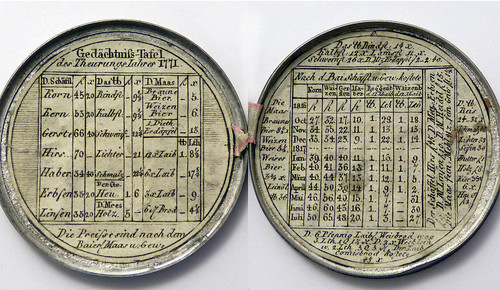
PREV ARTICLE
NEXT ARTICLE
FULL ISSUE
PREV FULL ISSUE
SCHRAUBTALER: MEDAL WITH A HIDDEN STORYE-Sylum supporter Shanna Schmidt featured a very unusual medal in her Newsletter #63 this week. I've seen some of these exhibited before, and they're remarkable pieces of work.
-Editor
 Schraubtaler. Nürnberg, Germany. 1817 Tin medal with hidden story, 32.43g (48mm, 12h). Depiction of starving family under a tree / Praying farmer in fertile landscape receives from a harvest wreath from girl, above angels. Within the taler are eight connected double-sided colored copper engravings and descriptions, four of which show the year of need (1816) and four the good year (1817), in the inside cover there are two glued, black and white copper engravings: 1816/1817 and a table with a comparison to 1771 in Bavaria.  These fascinating pieces are “coins” that can be separated into two parts and contain something inside whether it be a portrait of a loved one, story or precious item. They were extremely popular, particularly in Germany in the 1700 and 1800’s. The earliest known schraubtaler used coins from from 1486-1525. Many times, the coins used to construct the schraubtaler were from different cities and various dates, but most were out of circulation. The artistry and stories encapsulated within the coins are fascinating. For example, this particular piece details the starvation that took place in Germany in the year 1816. It also compares the year 1816/1817 to 1771 in Bavaria. This piece was made in Nürnberg, however, the majority of schraubtalers came out of Augsburg. These pieces reflected religious and political issues of the time. Schraubtalers were given as a present, a commemorative gift for a wedding or baptism, or for distinguished honors. Sometimes in arranges marriages, they were used to give a future spouse a glimpse of their future partners with a portrait enclosed. They also used them as packaging for precious items. For example, Queen Maria Theresia gave the bodyguard for her bedroom half a ducat that she enclosed in a schraubtaler. The most interesting thing about a schraubtaler is undoubtedly the content. The earliest have engravings or oil portraits put directly on the inside of the talers.  References: Pressler 439 (on colored plates within). Erlanger 6 Wondering where the name came from I put "schraub taler" into Google Translate and got back "screw taler". Is that because you screw the halves together and apart? -Editor
Shanna confirmed my guess. She writes: That is exactly what it means. It is a specialized term in German. To read the complete article, see: Wayne Homren, Editor The Numismatic Bibliomania Society is a non-profit organization promoting numismatic literature. See our web site at coinbooks.org. To submit items for publication in The E-Sylum, write to the Editor at this address: whomren@gmail.com To subscribe go to: https://my.binhost.com/lists/listinfo/esylum All Rights Reserved. NBS Home Page Contact the NBS webmaster 
|